
International Research Journal of Engineering and Technology (IRJET) e-ISSN:2395-0056
Volume: 12 Issue: 04 | Apr 2025 www.irjet.net p-ISSN:2395-0072


International Research Journal of Engineering and Technology (IRJET) e-ISSN:2395-0056
Volume: 12 Issue: 04 | Apr 2025 www.irjet.net p-ISSN:2395-0072
Prof Priyanka Sananse
Department ofInformationTechnology
K.C. College Of Engineering
priyanka.sonawane@kccemsr.edu.in
Veda Zapdekar
Department of Information Technology
K.C. College Of Engineering vedazapdekar@kccemsr.edu.in
Chinmayee Surve
Department of Information Technology
K.C. College Of Engineering chinmayeesurve@kccemsr.edu.in
Abstract - AR shoes utilize real-time object recognition, 3D modeling, along with motion detection to create immersive virtual try-on experiences. Using platforms like Lens Studio, they adapt seamlessly to users' leg movements, boosting online shopping and improving customer engagement. high-quality 3D visualization, and low-latency dispaying across various ARdevices.Beyondretail,ARshoeshaveapplicationsin gaming, artistic expression, and social media, fostering collaboration between brands, designers, and AR platforms. This study explores the transformative potential of AR in fashion, offering a creative and innovativeapproachtodigitalfootwear.
Key Words: AR, 3D Model, Shoes, Virtual try-on, lens studio,DigitalFashion,Retailinnovation
“Augmented Reality (AR) technology has emerged as a groundbreaking toolinvariousindustries, innovating theconsumerinteractionwithproductsandservices.In the fashion and footwear field, AR has introduced a transformativestrategyknownas"ARtry-on,"allowing users to visualize and digitally try shoes using their mobile devices or AR glasses. This innovative technologyoverlaysdigitalfootwearontotheuser’sfeet in real time, offering an engaging and dynamic experiencethateliminatestheneedforphysicaltry-ons.
The AR shoe try-on experience leverages advanced technologies such as real-time object recognition, 3Dmodeling, and movement tracking. By using smartphone cameras or other AR-enabled devices,
Shravani Rane
Department ofInformation Technology
K.C. College Of Engineering shravanirane@kccemsr.edu.in
Priya Tiwari
Department of Information Technology
K.C. College OfEngineering priyatiwari@kccemsr.edu.in
users can seamlessly "try on" different styles, colors, and designs of shoes, adjusting them dynamically to fit their feet and leg movements. This provides an efficient and engaging way for consumers to explore footwear options without being constrained by location or the need for physical samples. Shoe try-on applications are revolutionizing the online shopping experience by leveraging augmented reality (AR) and artificial intelligence(AI) technologies.Theseappsletcustomerto virtually try on shoes, providing a realistic visual overlay ofthefootwearontheirfootinreal-timevia theirmobile cameras. This innovative feature helps customers better assess how a particular shoe style looks and fits without needing to visit a physical store. In add it ion, some apps offer personalized size recommending accorfing to foot measurement and the history of their purchases, further enhancing the shopping experience and reducing the likelihood of returns. By integrating with e-commerce platforms, these apps streamline the buying process, making it easier for customers to explore, try on, and purchaseshoesallwithinasingleplatform.TheriseofAR shoestry-onholdssignificantpromiseforrevolutionizing online shopping and retail. It doesn’t only enhance users engagement even so reduces likelihood of returns by offeringusersaclearerideaofhowshoeswilllookalsofit. With digital solutions continues to evolve, AR try-on is poised to become a cornerstone in the digital shopping experience, offers both user and companies new opportunitiesforinteractiveandpersonalization.
In Analyzing augmented reality(AR) and virtual reality (VR) recent progress in educational paper in 2023, This methodologyinvolvedasystematicanalysisofAR-VR

InternationalResearch Journal ofEngineering and Technology (IRJET) e-ISSN:2395-0056 p-ISSN:2395-0072

Volume:12 Issue:04 |Apr2025 www.irjet.net
applications in educational purpose over the past 12 years. It sourced a total of 1,536 research paper retrieved from Scopus on specific inclusion criteria, focuses topics like, keywords, and abstracts. Using WordStatfortextmining..[1]
Research and Applications Overview, The focus was on the variousapplicationsofARintourism,includingwayfinding and navigation. This research further underlined the necessity for specific device compatibility and stable connectivity,systemresponsivenessandalsothechallenges associated with maintaining this updates with respect to contextofARintourism.[2]
In Augmented reality in architecture and construction education: state of the field and opportunities paper in 2022, The methodology of this study involved a comprehensive review and critical analysis o existing literature on the use of augmented reality (AR) in architectureandconstruction(ACeducation).[3]
PJanardhana Reddy, Augmented Realityis aneffective tool forthisemergingstudyingparadigm,makingthelearned in active role of self-directed studying, providing flexibility and interaction in teaching and learns process. We need to interactive studying methods and this changing role of education is inevitable with introduction of Augmented Realityineducationsector.[4]
Milgram, P., Milgram, P., Colquhoun, H., & Colquhoun, H. (1999). A Taxonomy of Real and Virtual World Display Integration.MixedReality-MergingRealandVirtualWorlds, 5–30..[5]
Mykhaylo Andriluka, Leonid Pishchulin, Peter Gehler, and Bernt Schiele. 2014. 2D Human Pose Estimation: New Benchmark and State of the Art Analysis. Published the IEEE Conference on Computer Vision and Pattern Recognition(CVPR).3686–Segmentation.InProceedingsof theIEEE/CVFInternationalConferenceonComputerVision (ICCV).9156–9165.[6]
In Augmented Reality Research and Applications in Education paper in 2022, The methodology of this study involved a comprehensive compilation and analysis of existingliteratureonAugmentedReality(AR) technologies and their applications in education. First,
Applicable sources were identified, focusing on peerreviewed articles, case studies, and practical examples that illustratetheuseofARinvariouseducationalcontexts.[7]
This states a proper approach to developing an Augmented Reality (AR) shoe try-on application, emphasizinguserengagement,technicalimplementation, andevaluation.
1.StudyandExamination:

Market Analysis: Conduct a comprehensive evaluation of current footwear market, focusing on consumer preferences,existingARsolutions,andindustrytrends.
User Research: Perform questionnaires and interviews were conduct to gain insights on user expectations, pain points, and desired features for virtual shoe try-on experiences.
2.DesignandPrototyping:
User Persona Creation: Develop user personas based on researchdatatorepresentvarioustargetdemographics.
CustomersMappingFlow:Createcustomersjourneymaps to identify key touchpoints, challenges, and opportunities intheshoppingexperience.
3.TechnicalDevelopment:
Platform Selection: Choose an appropriate AR development platform (like lensStudio and sketchHub) basedonprojectrequirementsanddevicecompatibility.
3D Model Creation: Collaborate with designers to make right 3D models of shoes, ensuring they are optimized for ARrenderingandcompatiblewiththechosenplatform.
4.ImplementationofARFeatures:
Real-Time Rendering: Implement the AR functionality to overlay 3D shoe models on the user's feet, ensuring accurate alignment and real-time tracking of foot movements.
User Interaction Development: Create features that allow users to interact with the AR experience, such as rotating theshoeview,takingscreenshots.
5.TestingandValidation:
Functional Testing: Conduct unit tests on individual components, such as the 3D model rendering and foot trackingfunctionality.
User Acceptance Testing (UAT): Engage a group of target users to test the application, gathering feedback on usability,accuracy,andoverallsatisfaction.
6.DeploymentandMarketing:
Integrating with E-Commerce Platforms: Ensure the AR application is easily integrated with avaliable e-commerce systems, enabling users to easily transition from the AR experiencetopurchasing.
MarketingStrategyDevelopment:Createamarketingplan to promote the AR shoe try-on feature, leverages social media,influencerpartnerships,andtargetsadvertising to reachpotentialcustomers.
7. Post-LaunchEvaluation:
Customer Analytic Monitoring: Implement analytic tool to track customers engagement and interaction within the app, emphasizing key performance indicators like interactionandconversionrates.

©2025, IRJET | ImpactFactorvalue: 8.315 |


InternationalResearch Journal ofEngineering and Technology (IRJET) e-ISSN:2395-0056 p-ISSN:2395-0072

Volume:12 Issue:04 |Apr2025 www.irjet.net
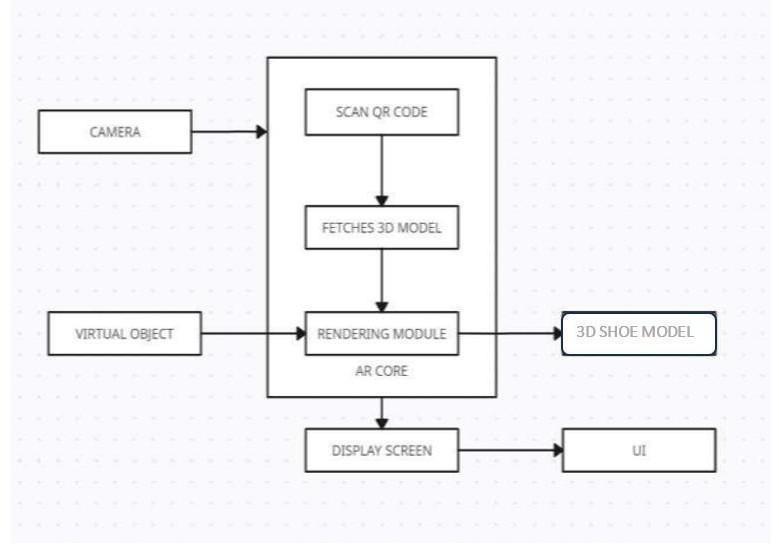
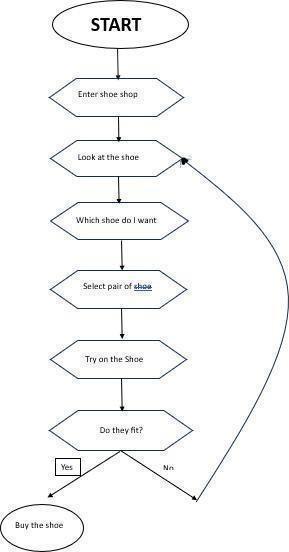


3. Related Work
Several innovative projects have explored the integration of augmented reality (AR) technology into Shoe try on. These initiatives typically aims to enhance the digital shopping experience for shoe items by allowing users to visualize the visual appearance of products within their foots in virtual spaces. By overlaying virtual images onto realenvironmentsthroughsmartphone/tabletscreens,AR makes users try virtually "try out" different pieces of furniture, experience with various models prior making purchasing decisions. Such applications not only streamline the shopping process but also contribute to reducing the likelihood of post-purchase dissatisfaction. Additionally, AR-based shoe try-on solutions have the potentialtorevolutionizetraditionalmethods.

Login page is your gateway to a virtual showroom i.e Solemate using AR where you can explore endless design possibilities. Whether you're seeking inspiration or ready to redesign, our AR technology lets you visualize shoes in your space before making any decisions. Sign in to unlock and try various attractive shoes. Dive in and let your imagination soar with our innovative AR shoe try-on platform.


InternationalResearch Journal ofEngineering and Technology (IRJET) e-ISSN:2395-0056 p-ISSN:2395-0072

Volume:12 Issue:04 |Apr2025 www.irjet.net
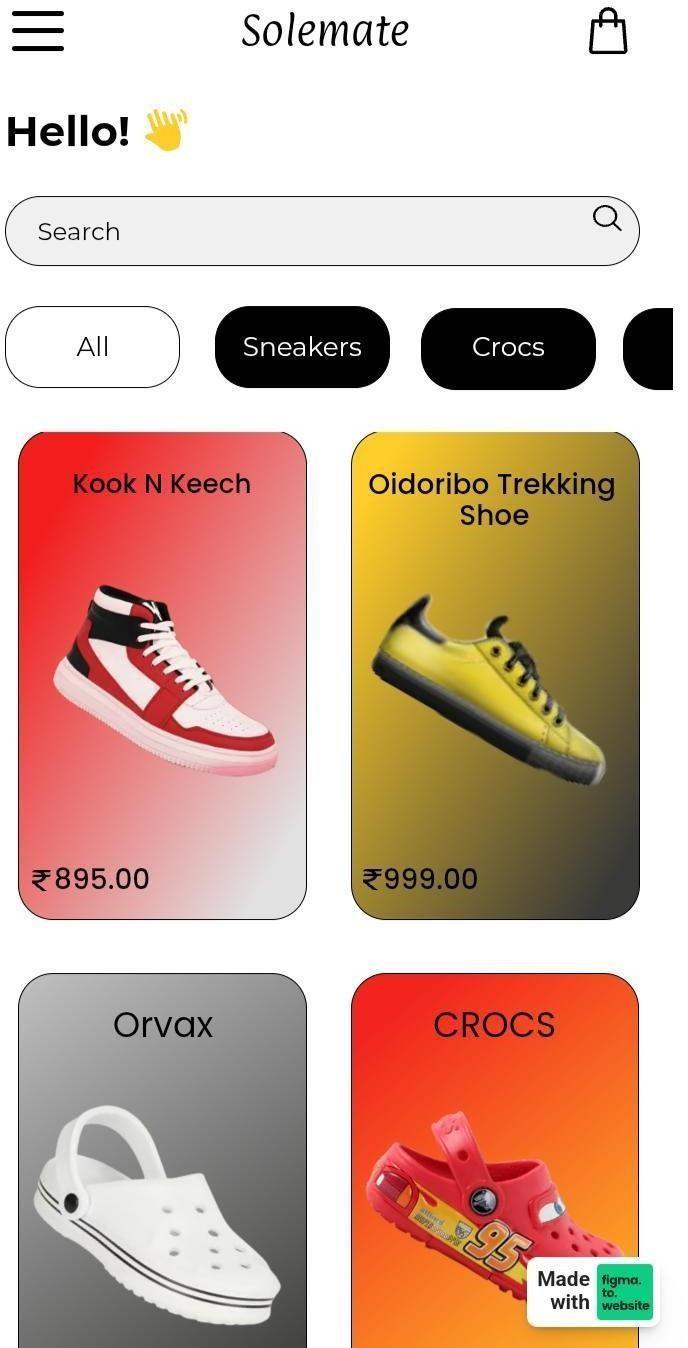
Fig.ProductPage
Step into a world where style meets technology with our innovative AR-powered shoe try-on experience. Explore ourcuratedcollectionoftrendyfootwearfromthecomfort of your home. Simply download our app, and with a quick scanofyourfeet,visualizehoweachpairlooksinrealtime. From sleek sneakers to elegant heels, our AR technology allows you to try on shoes with stunning accuracy, ensuringtheperfectfitandstylebeforeyoubuy..


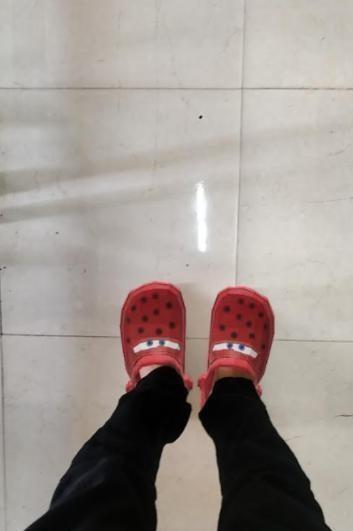
Augmented Reality (AR) is revolutionizing the way we shop for shoes. With AR view technology, customers can visualize how shoe will visual onto the users own foot before buying it. By simply using a smartphone/tablet, users can superimpose virtual shoe onto their real-world environment,allowsthemtoseehowdifferentmodelswill fit and complement their space. This captivating experiencedoesn’tonlyenhancestheshoppingprocessbut alsominimizes riskofbuyingitemsthatdon'tquitematch intendedaesthetic.ARviewforshoetry-onactasa bridge that closes the gap within virtual shopping and the traditional in-storeexperiences,empoweringcustomers to make confident and informed decisions from comfort of theirownhomes.


InternationalResearch Journal ofEngineering and Technology (IRJET) e-ISSN:2395-0056 p-ISSN:2395-0072

Volume:12 Issue:04 |Apr2025 www.irjet.net


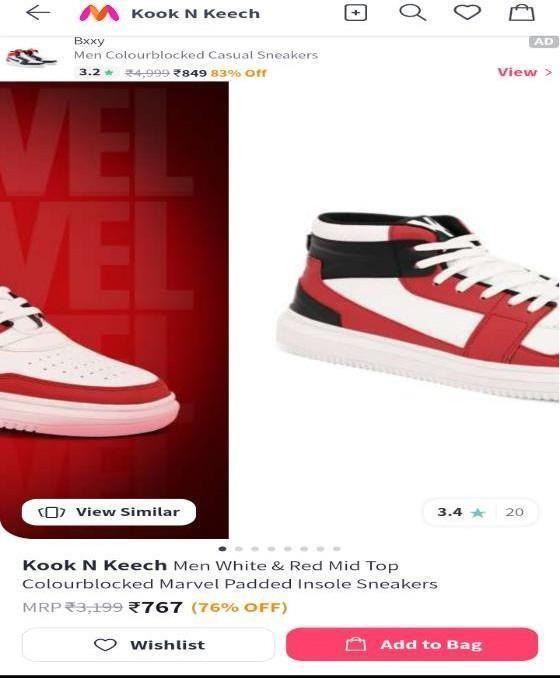
Fig.RedirectiontowebsitePage
Experience the future of footwear shopping with our cutting- edge augmented reality (AR) try-on experience. Exploreourcuratedcollectionofshoesfromthecomfortof yourhomeandseehowtheylookonyourfeetinreal-time using AR technology. With our seamless payment process integrated directly into the AR experience, user can seamlessly purchase your favorite pairs with just a few clicks. Say goodbye to uncertainty and hiiiii for a more immersiveandconvenient waytopurchasetheshoes. Step intothefutureoffootwear shoppingtoday


4.USESOF AUGUMENTEDREALITY
Augmented Reality (AR) has a wide range of applications across various industries, enhancing customerexperiencesbyoverlayingvirtualinformation ontothephysicalworld.Herearesomecommonusesof augmentedreality:
1. Gaming: Oneofthemostwell-knownusesofAR in gaming, where players can easily interact with digital objects and characters overlaid onto their real-world environment.GamesasPokémonGOandHarryPotter: Wizards Unite utilize AR to immerse players in augmentedrealities.
2. Education: AR enhances learning experiences by providing interactive and immersive content. Students can use AR applications to visualize complex concepts, such as anatomy models, historical events, or astronomicalphenomena,inamoreengagingmanner.
3. Retail: AR is transforming the retail industry by allowing customers to visualize products in their own spacebeforemakinga purchase.RetailerscanofferAR apps that enable customers to try-on digital clothing, preview furniture placement at homes, or see how cosmeticslook onusersfaces.
4. Navigation: AR navigation applications overlay directions and points of interest onto the real world, helping users navigate unfamiliar environments more easily. All these apps can provide real-time navigation cues,touristinformation,andpointsofinterestasusers movethroughtheirsurroundings.
5. Industrial Training: AR is used for training purposes in industries such as manufacturing, maintenance, and repair. Workers can receive step-bystep instructions overlaid onto equipment they are workingon,improvingefficiencyandreducingerrors.
The development of the Augmented Reality (AR) shoe try- on application is transforming the retail industry, particularly in footwear sector, by allowing customers to visualize various styles, colors, and designs on themselves on their foot from home. This innovation increasestheinteractiveshoppingexperience,reducing uncertainty, increasing customer satisfaction, and lowering return rates. With features like real-time tracking, 3D rendering, and user customization, the app evolves with changing consumer preferences, encouraging widespread adoption as AR becomes morefamiliarthroughsocialmediaandgaming.Future advancements, including AI-driven personalization for real-timesizerecommendationsandstylesuggestions


InternationalResearch Journal ofEngineering and Technology (IRJET) e-ISSN:2395-0056 p-ISSN:2395-0072

Volume:12 Issue:04 |Apr2025 www.irjet.net
[1]A comparative study of a Virtual footwear Try-on ApplicationsinVirtualandAugmentedReality
[2] Broschart, D., & Zeile, P. (2014). reviewed paper ARchitecture – Augmented Reality Techniques and Use Cases in Architecture and Urban Planning Daniel Broschart,PeterZeile,8(May),75–82
[3] Cerqueira, C. S., & Kirner, C. (2011). Developing Educational Applications with a NonProgramming Augmented Reality Authoring Tool, (June),2816–2825.
[4] Martin, S., Diaz, G., Sancristobal, E., Gil, R., Castro, M., & Peire, J. (2011). Computers & Education New technologytrendsineducation
[5] Mykhaylo Andriluka, Leonid Pishchulin, Peter Gehler, and Bernt Schiele. 2014. 2D Human Pose Estimation: New Benchmark and State of the Art Analysis. InProceedingsoftheIEEEConferenceonComputerVision and Pattern Recognition (CVPR). 3686– Segmentation. In Proceedings of the IEEE/CVF International Conference on ComputerVision(ICCV).


